Nvidia GeForce GTX 1060 Graphics Card Roundup
Inno3D GeForce GTX 1060 Gaming OC
Inno3D's GeForce GTX 1060 Gaming OC isn't the company's flagship, but rather a bread-and-butter workhorse in its 11-card portfolio of GP106-based products. We consider this a good thing. As one of the more affordable GeForce GTX 1060s (at least in Europe), the Gaming OC board appeals to a broader audience. You get a similar level of performance without spending an extra $40 or $50 (£20-30) on bells and whistles you might not need. It'll be interesting to see where Inno3D cut costs though, and what features it dropped to achieve a more attractive price.
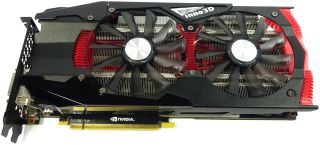
Technical Specifications
MORE: Best Graphics Cards
MORE: Desktop GPU Performance Hierarchy Table
MORE: All Graphics Content
Exterior & Interfaces
The fan shroud is made of black plastic and features red detailing that looks quite nice. We won't say the same for those piano-black bolt-ons that serve little purpose other than to collect fingerprints. After installing the card, you'll feel compelled to clean it off again.
Weighing in at 29 ounces (820g), this card is fairly light. It measures 11 inches (28cm) long, five inches (12.5cm) tall, and 1 1/3 inches (3.5cm) wide. It monopolizes two expansion slots and is neither particularly small nor oversized—it's just average. The blades of both fans have a diameter of 9cm, which is pretty common as well.


The back of the board is covered by a single-piece plate with some ventilation holes. Unfortunately, there are no thermal pads connecting it to the circuit board, so the plate does nothing to help with cooling. Because of the backplate, though, you must plan for an additional one-fifth of an inch (5mm) of clearance to avoid collisions with your CPU's cooler, particularly in small form factor cases. A lack of SLI support means you don't have to worry about fitting two GeForce GTX 1060s back to back in a case.

The top of the card features an unlit Inno3D label, and the shroud up there is narrow enough that you see the cooling fins behind it.
An eight-pin auxiliary power connector is located at the end of the card facing out, rather than back. As a result, the heat sink is cut out right above the connector. Interestingly, this can be explained by the fact that Inno3D uses Nvidia's reference PCB for the GeForce GTX 1070 to build its GTX 1060 Gaming OC.

Vertically-oriented cooling fins mean that hardly any air escapes through the slot bracket, even though narrow slits in the metal suggest otherwise. The vertical fins are cheaper to implement, since they make it easier to arrange the heat pipes. You just have to be diligent about exhausting all of that waste heat out of your case.


The slot cover exposes five outputs, four of which can be used simultaneously to drive multi-monitor configurations. In addition to one dual-link DVI output (which lacks an analog signal), you also get one HDMI 2.0 interface and three DisplayPort 1.4-capable connectors.
Board & Components
A glance at the board gives us a sense of déjà vu; as mentioned, Inno3D relies on the longer GeForce GTX 1070 reference board. Of course, the components it uses to build the 1060 are simpler, but because Nvidia's GP106 processor is pin-compatible, it's not a problem to use the 1070's PCB.
The 5+1-phase design, similar to Nvidia's GeForce GTX 1070 Founders Edition, relies on the uPI Semiconductor uP9511P as its PWM controller. All five of the GPU's power phases are fed by the eight-pin auxiliary connector; only the memory's phase is driven through the motherboard's PCIe slot.

The voltage of the five GPU phases and one memory phase is controlled by no-name dual-N-channel MOSFETs that require external gate drivers. Inno3D's coils of choice are clones of Foxconn's Magic series, which we'd expect to find in the lower price segment.

Two capacitors are installed right below the GPU to absorb and equalize voltage peaks.
It's worth noting that only six of the eight available memory emplacements are populated with Samsung K4G80325FB-HC25 modules. Each one adds 8Gb (32x256Mb) and operates at voltages between 1.305 and 1.597V, depending on clock rate. In total, they add up to this card's 6GB of GDDR5.
Power Results
Before addressing power consumption directly, let's take a look at the relationship between clock rate and voltage. As we've seen already, the GPU's frequency drops significantly once the card is fully exercised with a gaming workload.
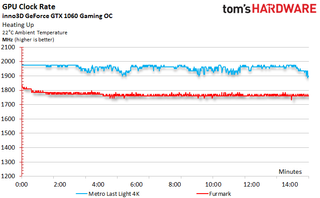
After warm-up, the initial GPU Boost frequency of 1974 MHz falls to an acceptable average of 1949 MHz under load. The slope of this curve is mirrored by our voltage measurements: what started at 1.043V in the beginning falls to an average of 1V. The drops we observe correspond closely with dips in GPU clock rates.
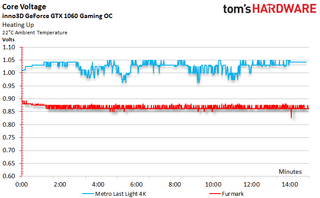
The lowest GPU clock rate measured at idle is about 203 MHz.
We took our measurements using a variable low-pass filter, so we mention short load peaks only as a side note (see the grayed-out bar in the chart below), since those peaks are rarely relevant in practice.
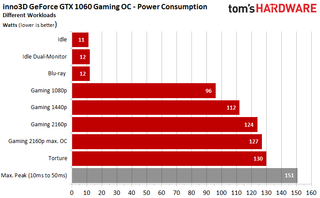
Power Connector Load
Since Inno3D's GeForce GTX 1060 Gaming OC doesn't use the motherboard slot's 3.3V rail, we left it out of our chart.
The power distribution we observe shows a heavy bias toward the auxiliary power connector, which supplies about 95W.
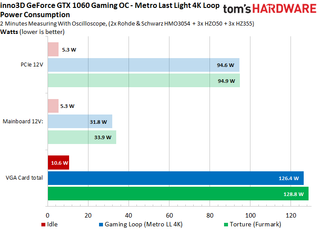
Here's the data for the gaming and stress tests:


Power consumption on its own only tells us part of the story. The PCI-SIG specifies a maximum of 5.5A at the motherboard slot, and we're showing a reading under 3A, which puts Inno3D's GeForce GTX 1060 Gaming OC in the green.
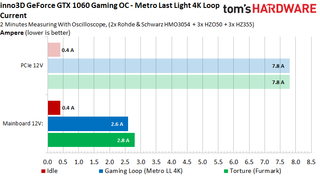
Of course, we have the data for measured currents as well:


The Cooler & Its Performance
The question remains: what kind of performance can we expect out of this budget card's cooler? According to the label on its backplate, we should be enjoying the benefit of HerculeZ Design!
Inno3D's backplate is screwed into the cooler from behind and into the PCB from the front. Spacers measuring almost 3mm tall allow some airflow between the board and backplate.
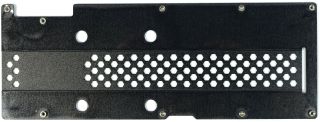
This isn't one of the beefiest coolers we've tested. It employs horizontally-oriented fins, two nickel-plated 6mm heat pipes above the base plate, and four nickel-plated 6mm pipes towards the card's rear. For cost reasons, the heat sink and base plate are both made from aluminum.

It deserves a positive mention that the heat sink for the MOSFETs is built into the cooler and does an excellent job. Unfortunately, the coils do not benefit from this implementation.
A measurement between 140 to 142°F (60 to 61°C) during our gaming loop, peaking at 145°F (63°C) in a closed case, shows that Inno3D's cooler works amazingly well.
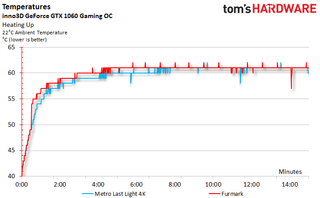
Measurements taken with the backplate removed and the cooler mounted directly to the PCB show that Inno3D's thermal solution still has some performance in reserve. Results from our gaming loop and stress test reveal no abnormalities, except for extremely low temperatures around the VRMs thanks to an integrated sink responsible for drawing heat away from that area.

In both our gaming workload and stress test, Inno3D's thermal solution works the way it should, leaving us with one of the coolest boards in today's round-up.
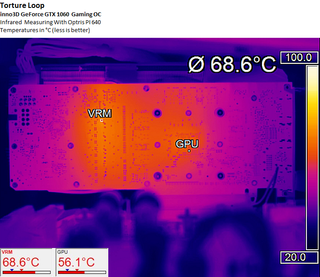
Although the pressure to cut costs is apparent in several place, this cooler does a great job. Performance was clearly one area Inno3D refused to compromise.
Sound Results
A picture-perfect implementation of proper hysteresis is critically important to Inno3D. However, fan speed readings as high as 1400 RPM point to where this card's great cooling performance comes from. We think there's room to dial back a bit, since even at 1000 RPM there'd be enough cooling headroom to keep Nvidia's GP106 operating at under 167°F (75°C), while at the same time reducing noise quite a bit.
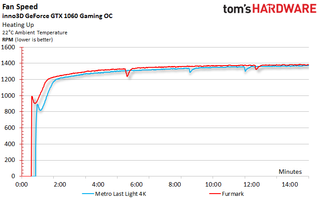
When the card is idle, its noise level is imperceptible due to a semi-passive mode. There's no point taking readings in that state.
Under load, a 35.7 dB(A) reading is neither loud nor really quiet, but instead average. If you're looking for a much quieter result, take advantage of the cooler's headroom and use a third-party tool like MSI Afterburner to dial in a lower fan speed.

A spectrum analysis turns up significant vibrations in the low-frequency range. Given this card's price tag, though, it's hard to expect perfection.
Inno3D GeForce GTX 1060 Gaming OC
Reasons to buy
Reasons to avoid
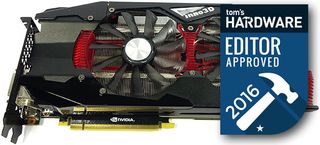
MORE: Nvidia GeForce GTX 1080 Roundup
MORE: Nvidia GeForce GTX 1070 Roundup
MORE: All Graphics Content
Current page: Inno3D GeForce GTX 1060 Gaming OC
Prev Page Gigabyte GeForce GTX 1060 G1 Gaming 6G Next Page MSI GeForce GTX 1060 Gaming X 3GStay on the Cutting Edge
Join the experts who read Tom's Hardware for the inside track on enthusiast PC tech news — and have for over 25 years. We'll send breaking news and in-depth reviews of CPUs, GPUs, AI, maker hardware and more straight to your inbox.
-
Achaios @Igor: I really appreciate your articles. I have one small request: PLEASE consider adding benchmarks results from 3D MARK FIRESTRIKE so that we can compare your results with our GPU's. Really appreciated your "Das große Radeon RX480 Test-Roundup - Teil 1" too, though again, there are no 3D MARK FIRESTRIKE results.Reply -
bloodroses Darnit, the Zotac and Gigabyte mini models weren't covered. I was curious to see how those two compare vs. the EVGA model since I'm working with limited space inside my case.Reply -
agent88 I bought a retail MSI Geforce GTX 1060 Gaming X card last month and it was defaulted to OC mode by default. This is the same as the test version that the press received. Wondering if MSI is shipping this version to all consumers now or if I just got lucky with a "golden sample". Also, MSI provides both the MSI gaming app and afterburner software. The gaming app offers 1-click option to choose the OC mode. AReply -
shrapnel_indie Good to see a roundup... However, I think the 3GB and the 6GB belong in the same category as much as the RX-470 and RX-480 do. That is: they don't.Reply -
FritzEiv We're working on getting more cards in for all categories (1080, 1070, 1060), including from Asus, which is working on getting us cards. In fact, we'll have an update to our 1070 roundup shortly (2 new cards). And we're working on a 480 roundup as well.Reply -
mikeangs2004 Reply19457023 said:Darnit, the Zotac and Gigabyte mini models weren't covered. I was curious to see how those two compare vs. the EVGA model since I'm working with limited space inside my case.
they are kind of for the niche market just like in the days of low profile units -
Ancient1 Regarding the EVGA GTX 1060 SC :Reply
Could someone who disassemble it post the measurements ( WxHxL ) of the HEATPIPE ?? I plan on carving a Copper Heatsink, rather than Thermal Pads.
I am also thinking about HS for the memory etc , along the Pipe. But it will impact AirFlow and might degrade the HeatPipe efficiency as , to my knowledge, Heatpipe depends on temperature difference between the cooled GPU and the Heat Expelling (to the fins) areas of it.
Please post, Google will find it :)
Thanks in advance